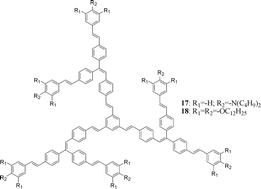In this paper we describe a convenient and convergent approach to the synthesis of novel and highly luminescent (diphenylvinyl)benzene (DPVB)-based conjugated star-shaped molecules, which can be used as emitting dyes in doped OLEDs. The versatility of this synthetic route allows tuning of the HOMO–LUMO energy levels of the materials by means of the introduction of different electroactive peripheral groups. Two related star-shaped dyes have been prepared, one with amine and one with alkoxy end groups, and have been characterized using optical spectroscopy and cyclic voltammetry. The energy levels of the dyes are found to lie within the band gap of a polyfluorene (PF) derivative such that energy transfer from the photoexcited PF to the dyes takes place. In OLEDs that contain 1 wt% of dye in PF, the emission is predominantly from the dye. Although the EL spectra are similar for the two dyes, other device characteristics differ greatly. OLEDs using the amine-terminated dye have a luminance that is a few orders of magnitude lower than that based on the alkoxy-terminated dye. The differences are explained by the positioning of the HOMO and LUMO levels of the two dyes compared to those of PF. The dye with the amine end group can act as a deep trap for holes, reducing charge transport in the film.

You have access to this article
 Please wait while we load your content...
Something went wrong. Try again?
Please wait while we load your content...
Something went wrong. Try again?


 Please wait while we load your content...
Please wait while we load your content...